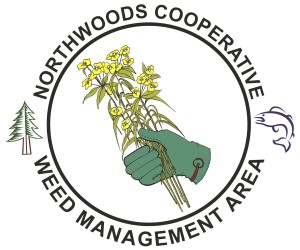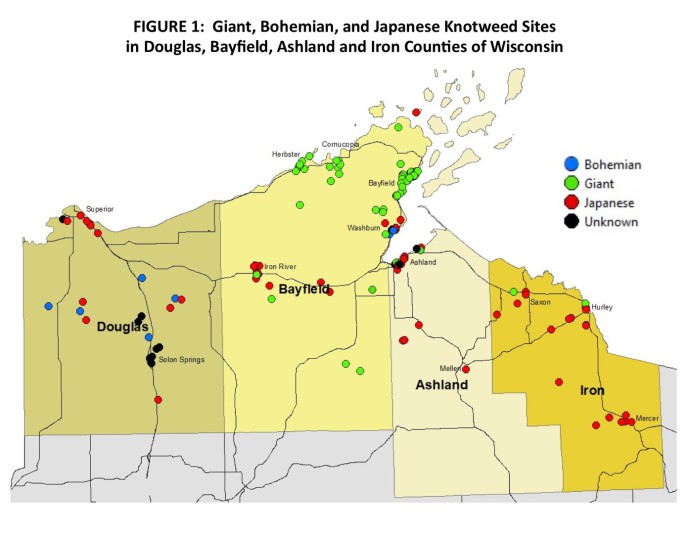Monitoring, Treating, and Controlling Knotweed Sites in the Northwoods Cooperative Weed Management Area (NCWMA)
Introduction
Since 2008, the Northwoods Cooperative Weed Management Area (NCWMA) and its partners have been tracking and treating invasive knotweeds within its region which includes Ashland, Bayfield, Douglas and Iron Counties in northern Wisconsin (Figure 1). Invasive knotweeds that occur in the area include Japanese knotweed (Fallopia japonica), Giant knotweed (F. sachalinensis), and their hybrid, Bohemian knotweed (F. X bohemica). Work has focused in the Bayfield Peninsula as nearly half of known occurrences are located in that region. The number of sites treated per year has varied and consistency in treating and monitoring sites has been a challenge. This project focuses on evaluating the effectiveness of treatments over the years. To prioritize future treatments of sites, sites were classified by basic features such as land ownership, population size, proximity to water, whether they are in landscaped areas (yards), and whether they are near or in forests. Occurrences in yards may have little ecological threat, however, they are difficult for landowners to treat on their own and have the potential to damage foundations and pavement. Other occurrences are more of an ecological threat as they have spread to shorelines, roadsides, stream banks and ravines.
Treatment methods
The NCWMA has used different herbicides and treatment methods on knotweed sites over the years. Different partners have access to different herbicides and equipment. Initially glyphosate was used. Milestone (aminopyralid,1/2 oz per gal) has been used since 2009, but more commonly in 2013 and 2014. Vanquish (dicamba, 5 oz per gal) has been used predominantly in 2016, 2017 and 2018. Vanquish allows earlier treatments in June and July prior to pollinator activity, while Milestone is most effective later in the season when flowers are present. Cut stump treatments with Milestone were done in 2014. Most treatments have been done by foliar spraying with backpack sprayers. All herbicides have had somewhat mixed results with the need to repeat treatments for multiple years.
Landowners
Landowners must sign a hold harmless permission form in order for the NCWMA to begin herbicide treatments. The forms are good for five years, so that they do not need to be signed annually, although landowners are contacted annually prior to treatments.
Characteristics of Knotweed Sites
Of the total known sites in the NCWMA, 85% are on private property. In 2018, 109 of the total 192 known sites in the NCWMA were visited. Of these sites, 27% were near a water body or wetland, 40% were contained within a landscaped area or yard, and 47% were located in or near forested areas. Table 1 (below) shows the knotweed species in sites within the NCWMA. The Bayfield Peninsula has 44 percent of all known knotweed sites. Within the Peninsula, 97% of the sites in Herbster, Cornucopia, and the City of Bayfield are giant knotweed, while other communities have predominantly Japanese knotweed. Sites listed as “unknown,” were not identified by species when they were visited.
Positive Results:
No plants were found at nine knotweed sites in 2018 after 1 to 3 treatments completed previous years. Typically the treatments were completed once per year. Five of these sites were small when first discovered, while three were medium sized. However, one site (Figure 2a & b) was a large, dense population that was treated two times and has not been seen since 2014. Eleven other sites had a significant decrease in size after one or two treatments.
Mixed Results:
Most sites take numerous treatments over many years to control. Some large dense populations have shown great initial results, but plants still linger annually. Twenty sites have been treated 1 to 2 times with no significant change in the size of the populations. The populations may have been treated in the past and rebounded after a gap in treatments or they may be large. Sixteen populations have been treated 3 to 7 times with medium to large decreases in size. Site B (See Figure 3a & b) in Bayfield has been treated at least 6 times since 2011. Although the large patch along the driveway is gone, the site still has many plants scattered in a large area of the side yard. Site C (See Figure 4a & b) was treated three times. The large dense patch is smaller, but many plants persist and have spread down into a ravine behind the church.
Poor results:
Eleven knotweed sites have been treated three to five times and have a minimal decrease in size when visited in 2018 compared to their pre-treatment size. A few of these had decreased after multiple years of treatments, but treatments were inconsistent in recent years and the knotweed rebounded. Some of these are very large with multiple patches. Some years the entire population may not have been thoroughly treated. Site D (Figures 5a, b & c) was treated starting in 2008. By 2015, Site D had been treated four times and was much smaller with scattered patches. Site D has not been treated since 2015. In 2018, the site is not as big as 2008, but it once again is a very dense and large population.
Partnerships spanning four counties
Ashland County: The Ashland County Land and Water Conservation Department has tracked sites in GIS and treated eight of the twenty known sites. The NCWMA will work to assist in treating sites in the future.
Bayfield County: Bayfield County has the most severe problem with knotweed in the region. It has 131 documented knotweed sites. The NCWMA and partners have treated 84 sites at least once since 2008. The NCWMA has “Knotweed Knockouts” in Bayfield County that bring partners together for treatments. The Bayfield Aquatic Invasive Species (AIS) program (within the Bayfield Land and Water Conservation Department) and the Wisconsin Department of Natural Resources participate annually in such events. Other partners that have helped include the U.S. Forest Service, the Great Lakes Indian Fish and Wildlife Commission (GLIFWC), the U.S. Park Service, the Red Cliff Band of Lake Superior Chippewa, and volunteers.
Douglas County: The Douglas County Forestry Department has treated some sites. Most of the 22 known sites have not been treated. The City of Superior is working to treat two sites in the city in 2018. A number of large sites have been found in private landscaping around Lake Minnesuing which is close the Brule River State Forest. The NCWMA assisted in treating one of these sites in 2018 with the Wisconsin DNR.
Iron County: The Iron County Land and Water Conservation Department has treated nine of the nineteen documented knotweed sites since 2009 and has eradicated two sites. Five of the sites were documented in 2018. NCWMA is working to lead treatments in the future and has assisted for a few years.
Challenges
- The NCWMA spans a large area. Treating sites throughout the region is challenging.
- The number of knotweed sites is daunting. There are nearly 200 populations of knotweed documented. Numerous more sites are undoubtedly within the region that have not been documented.
- Sites need to be treated and monitored for multiple years to eradicate knotweed.
- Dead and cut stalks can be unsightly. If moved to compost site, new infestations can be started. Four sites within the City of Bayfield are in locations that yard compost is dumped.
- Given the size and density of sites, private landowners have difficulty treating knotweed on their own.
- Knotweed occurs in difficult to treat areas:
Future Knotweed Management
- Prioritize sites to focus on treating a manageable number of sites annually.
- Use the Wisconsin DNR’s Weed Management Area-Private Forest Grant to treat high priority sites in forested private properties.
- Reach out to different and new partners to assist in treating in all four counties.
- Assist landowners in teaching them how to treat knotweed on their property.
- Find additional funding and resources to treat more sites each year.
- Develop a long-term management plan so that once treatment starts on a site, the treatments and annual monitoring continues for 5 years after no knotweed plants have been documented.
- Planning should include restoration of sites that are devoid of vegetation after knotweed removal.
- Share management ideas with other local weed management organizations in region, such as the Duluth CISA in Minnesota.
Acknowledgements: The NCWMA would like to thank the U.S. Forest Service’ for funding through the Great Lakes Restoration Initiative for Cooperative Weed Management Areas. In addition, the NCWMA thanks the Wisconsin Department of Natural Resource for its funding through the Weed Management Area Private Forest Grant.
PDF of the NCWMA Poster in a printable size.
knotweed umisc 2018 small version.pdf
Adobe Acrobat document [4.4 MB]



